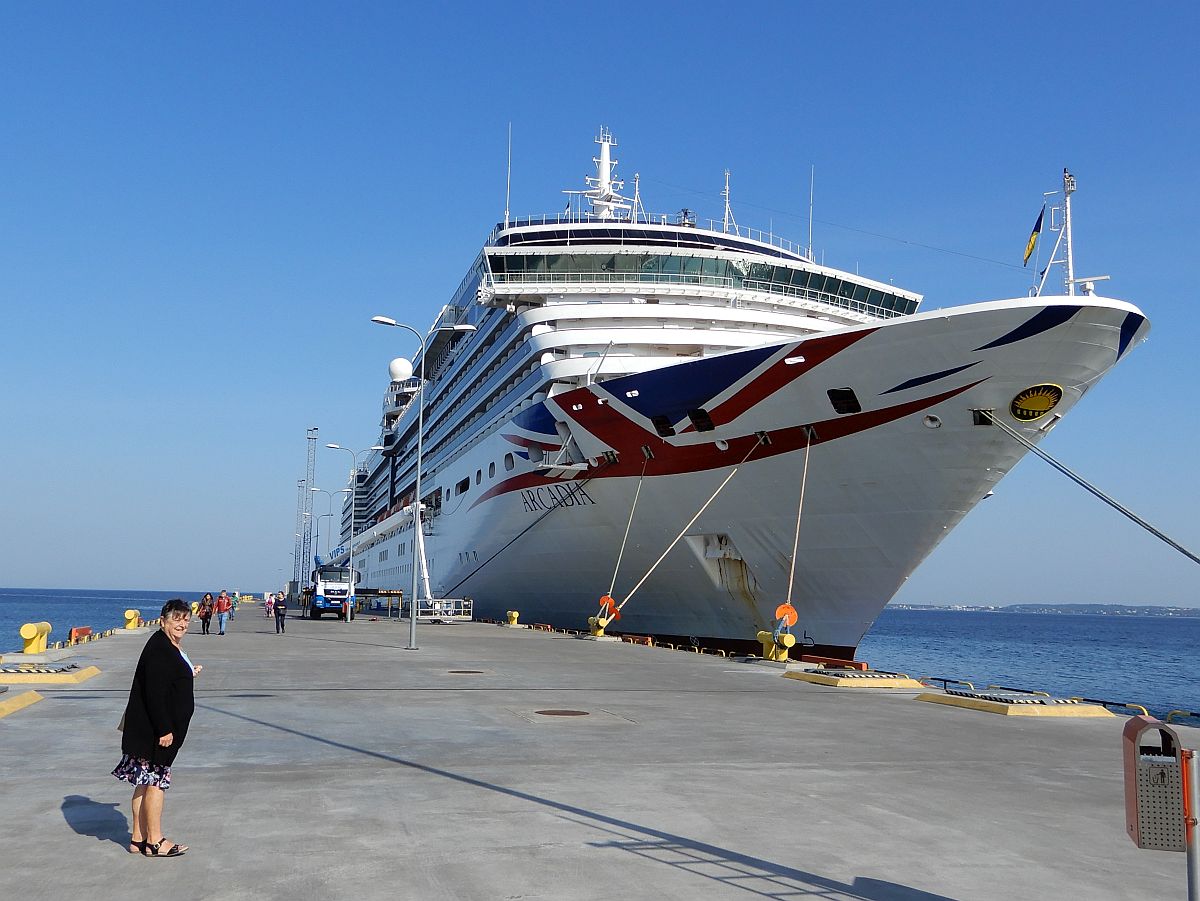
| Go to Allan's Page | Our Home Page | Holidays Home Page | British Canals Page | Go to Deb's Page |
| FlickR album of these photos | Part 1: From Southampton to St Petersburg |
We awoke to a beautiful, cloudless sky and a superb view of Tallinn, the capital of Estonia. Knowing virtually nothing about Estonia, we were keen to get started on a sightseeing trip. A coach took us the short distance into town, and then dropped us at the foot of the old city walls on the other side of the hill.
 |
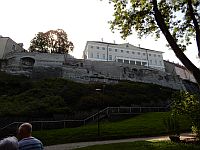 |
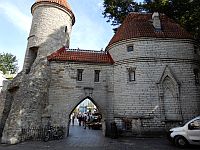 |
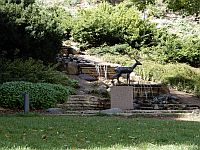 |
Our first view of Tallinn |
The ancient city walls |
One of the original gateways into the city |
There are some beautiful statues in the city |
The ancient hilltop city itself was incredibly beautiful. There were narrow twisting streets between the ancient buildings, including a street of craft workshops which were really fascinating. We spent a short time at the town square where we snapped up a few souvenirs including several items of Baltic amber, before visiting a quaint old restaurant to sample some local delicacies.
I can definitely say that we both loved Tallinn and would love to return to see more of the city and the country around it at some time in the future. We were particularly impressed at how unlike Russia this country was, despite its close proximity to the Soviet state, in both its own physical and historical characteristics and also those of its people and their attitudes to life.
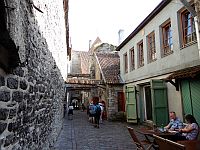 |
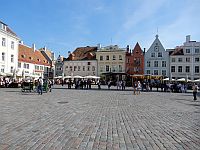 |
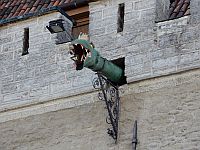 |
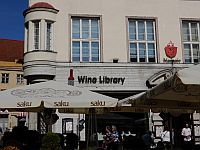 |
A typical street in Tallinn; this one had several craft workshops |
The fine City Square |
A fantastic gargoyle on the wall of the old Town Hall |
Debbie really wanted to visit this library! |
When we returned to the ship I saw that there was an archery session on the top deck, scheduled to take place as we were leaving port. I had tried to join one such session twice before, but on each occasion the weather had caused it to be cancelled, so I was very happy to join this one; until I saw what it comprised. For safety reasons they were using plastic arrows with rubber suction tips, and with a slight wind blowing the arrows course was a random lottery. It was, however, a lovely warm afternoon and we were each happy to spend some time simply relaxing in a couple of the deck-chairs with a good book.
The strength of the wind steadily increased during the evening until it reached 55mph overnight, but the ship remained amazingly stable in the adverse conditions. The outdoor gangways however were all locked tightly, to prevent anyone from being blown away, which concentrated our attention on the condition of the ship itself. We realised that there were just a few problems: for example most of the time about half of the public toilets were out of order; at any time about 1 in 3 of the lifts between decks was not working; the roof over the swimming pool area on the top deck was leaking badly whenever the wind blew the rain against it, causing the floors to be slippery amongst the slalom trail of buckets that were trying to collect the drips; in fact most of the ceilings on every deck from top to bottom were leaking drips of water into dozens of strategically-placed buckets along the corridors (we never did discover if it was rain water, swimming-pool water, drinking water, or something else), and the wet-room next to the Jacuzzi was permanently closed so that its tiled floor could be dug up to fix a problem (presumably a leak). Hmmm, maybe the ship was not so Posh after all. We also suffered one unexpected side-effect from the weather, in that the wind played the myriad of small openings in the outside bulkheads as if the front of the ship around our cabin was a giant pipe-organ. The rising and falling crescendo of chords (and dischords) made sleeping almost impossible.
The next morning we awoke in Riga, the capital of Latvia, which was another country that was new to us. We had travelled 2 miles up the river into the city itself, stopping just a few few yards short of the first of its low bridges. We had originally booked a historical tour of the city which was to finish in a local brewery, but there had not been enough interest amongst the other passengers so it had been cancelled, and we had to struggle to arrange an alternative tour because the on-board shore-excursions office had closed itself just a few minutes after announcing the cancellation. However we had managed to book a place on a tour which would show us the city of Riga from a variety of different modes of transport.
Our Latvian guide for the day was very knowledgeable about the country's history, and also had a great sense of humour. Her comments included "The Russians never invade countries, they only liberate them; they have liberated Latvia several times" and "We have been ruled by the Russians, by the Scandinavians, and by the Germans amongst others. Then after we had fought for our independence, we opted to give it away and now we are ruled by the EU instead"
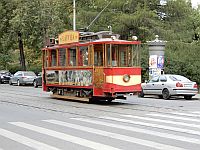 |
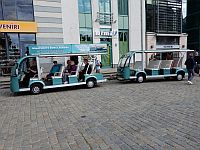 |
We loved the look of this vintage tram, but we did not get the chance to ride on it |
Instead we toured the city on this modern equivalent which they termed a 'trolley bus' |
The coach dropped us in the centre of Riga, near to the impressive Freedom Monument which had been erected in 1935 to celebrate Latvia's independence, the statue at the top depicts Liberty holding 3 stars to represent the 3 historical regions of Latvia. The monument is situated next to a beautiful park which has a small canal running through the centre of it. We transferred here to a little electric 'trolley bus' which bumped its way down the narrow cobbled streets, scattering pedestrians in every direction, and took us to the city square with its beautiful town hall.
The Trolley Bus returned us to our starting point by the Freedom Monument, then we strolled through the flower beds of the park and down to the canal where our next mode of transport, a beautiful little passenger launch, was waiting for us.
We cruised along the canal, through the park and past the Opera House, then a short tunnel under the roads took us out on to the river. Passing under several bridges we had a superb view of our ship before returning to the canal at the other end of the park. Our guide pointed out to us how the trees were each protected with a small fence; apparently this was necessary to protect them from all the beavers that have taken up residence on the banks of the canal.
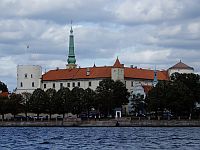 |
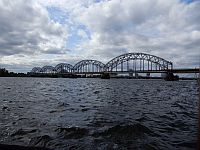 |
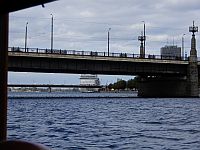 |
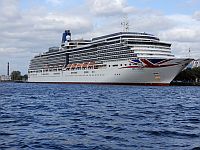 |
The river provides some interesting views of Riga |
We felt very small on the river on our little launch ... |
... as we passed under Riga's bridges ... |
... which gave us a good view of our cruise ship |
We agreed that Riga was another city that we would love to visit again, for as with Tallinn, our visit there had been all too short. The ship, however, was anxious to get away promptly as it was a long way to the next port of call, the port of Warnemunde near Rostock in Germany, and the weather forecast showed us heading into Force 10 gales for most of the night. Again the ship was very stable in the heavy seas, but the whistling of the winds outside our cabin window kept us awake for much of the night. The maintenance staff tried unsuccessfully to fix the problem but eventually admitted defeat and we were give the keys to an alternative cabin to use the following night; however this cabin was very small and was a long distance from ours, so rather than traipse the length of the ship in our nightwear we simply buried our heads under the pillows and got as much sleep as we could in our own cabin.
The next day we sat and ate a wonderful afternoon tea in the ship's fine dining restaurant, attended a superb piano recital in the afternoon, and after dinner we enjoyed excellent concert from the guest vocal group on stage; it was a day which made us feel that we were properly living the POSH life.
We had never heard of Warnemunde, which serves as the port for Rostock in northern Germany. It is near the Eastern end of the Kiel canal, but our ship was too big for the canal so it would be going the longer way around the North of Denmark. Oh well, we will just have to travel on a smaller ship to traverse the Kiel Canal.
We took a coach just half-way into Rostock (which was, our guide proudly told us, the home of the Heinkel jet plane which had preceded Sir Frank Whittle's work by several years. The guide also told us about the V1 rockets, which had used Heinkel's jet engine during WW2; apparently more people were killed from explosions and chemical accidents in the factory were they were manufactured, than were ever killed by the rockets themselves. Then, half way into the city, we transferred to a vintage tram for a sightseeing tour of the city before disembarking at the town square.
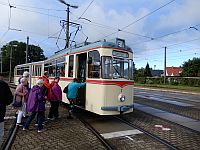 |
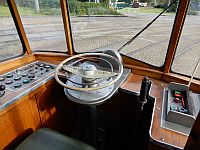 |
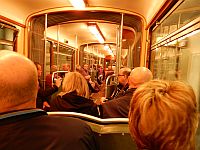 |
 |
Boarding the vintage (1960's) tram |
Why does a tram need a steering wheel ??? |
The interior of the tram |
The town square where te tram left us |
We admired the old buildings in the centre of the city as we walked towards the magnificent 13th century Church of St Mary, but were told how they were nearly all just modern reconstructions after almost the entire city had been bombed during the war. The interior of the church was spectacular, and the guide explained that the RAF had refrained from bombing it although they had destroyed the rest of the town, because it made such a good navigational landmark for them. Inside the church was a huge calendar-clock whose face was just a few feet from a main wall; making it almost impossible to see properly; apparently they had completely run out of better places to put it when it was completed.
After a walk around the town, during which we had the time to sit and enjoy a glass of beer in the sunshine of the main square, we walked to the river-front to take a very enjoyable boat-trip back up the river to our ship at Warnemunde.
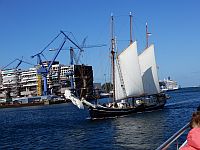 |
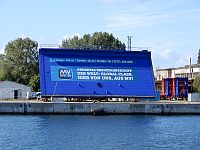 |
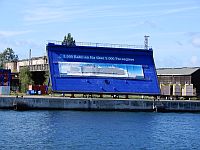 |
This beautiful ship was sailing up the river towards Rostock |
This shipyard is building the biggest cruise-ship in the world. Over 1000 ft long and 20 decks tall, it will carry 5000 passengers |
|
Walking back to the ship at Warnemunde, we passed an amazing display of sand-sculptures. I have never before seen anything like them!
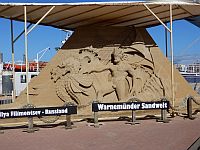 |
 |
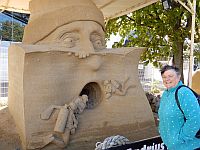 |
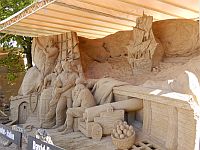 |
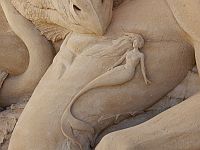 |
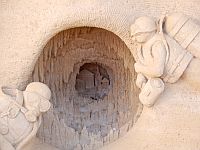 |
Sand sculptures of Poseidon, and the Flying Dutchman |
Sand sculpture 'Sea Monster with Sirens' (and detail) |
Sand sculpture 'In search of Jacques Cousteau' (and detail) |
And so we rejoined the ship for the final part of the journey, heading into a force 8 gale across the North Sea and up the Channel to Southampton. It had been a wonderful trip, completing our "Eastern European Ring', although we had been rather disappointed with the atmosphere of such a big ship; in future we will definitely try to travel on smaller ships (maybe this will let us transit the Kiel Canal next time). All the same, we enjoyed ourselves very much on this cruise and we visited some wonderful places including St Petersburg for the third time and both Riga and Tallinn for the first time; we would love to visit these places again.
| FlickR album of these photos | Part 1: From Southampton to St Petersburg | |||
| Go to Allan's Page | Our Home Page | Holidays Home Page | British Canals Page | Go to Deb's Page |
All pictures on this site are © Allan Jones unless otherwise stated